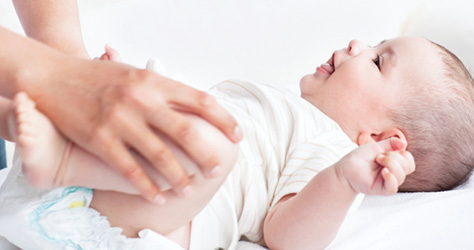Nappy rash is something most babies (and parents!) will experience at some point.
From preventing nappy rash, to spotting it’s various forms, to treatment... Bounty has your baby’s bottom covered!
At a glance
- 'Common' nappy rash usually clears within a week
- Allow fresh air to get to their bottom as often as possible
- Change nappies regularly

What causes nappy rash?
Nappy rash is caused by the skin on your baby’s bottom becoming irritated by its nappy. There are many reasons for this including bouts of diarrhoea, sensitive skin, washing powder chemicals or prolonged contact with wee or poo. Because the skin on a baby’s bottom is so sensitive and delicate it is perfectly normal for your baby to get nappy rash at some point no matter how careful you have been.
Thankfully, ‘common’ nappy rash usually clears up within a week.
Preventing nappy rash
You can help to prevent nappy rash as much as possible by keeping your baby’s bottom clean and dry. Here are some handy hints for happy nappies:
- Change their nappy regularly. Check every couple of hours that their nappy is still clean and dry. Change them after a feed and when you put them down to sleep.
- Wash the entire area – including all the folds of skin – with warm water and cotton wool or age-suitable baby-wipes.
- Ensure that the entire area is completely dry – including folds of skin which can easily trap moisture.
- Let them lay on a towel or changing mat with no nappy on as often as possible to allow fresh air to get to their bottoms.
- Fasten their nappy so that air can still circulate inside it and make sure that it is not rubbing or chafing.
- Avoid talcum powder as this can cause friction and irritation.
- Use a barrier cream.
Types of nappy rash
Common nappy rash looks like red, sore skin. This should clear up after a week and may even disappear overnight.
Your Health Visitor or pharmacist may be able to recommend an age-suitable nappy rash cream if appropriate. If the rash gets worse or doesn't go overnight it’s best to seek medical advice.
Fungal nappy rash is a form of thrush. If you see tiny red spots or swollen genitals this could be a sign of fungal nappy rash and it is best to speak to your health visitor or GP so that they can recommend treatment.
Bacterial nappy rash is made up of infected spots and your baby may well also have a fever. If you suspect your baby has bacterial nappy rash, it is best to speak to your GP asap so that they can advise you on treatment.
Noticed markings or a rash on your baby’s skin? Check out our guide to common baby skin conditions or where to go for medical advice. Or read our tips on looking after their delicate skin.